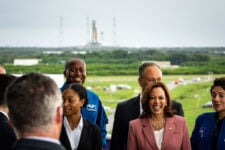
Abstract image of a Orbital space station in the form of a starry sky or space, consisting of points, lines, and shapes in the form of planets, stars and the universe. Vector business concept
WASHINGTON — Vice President Kamala Harris today announced a new interagency effort to build a domestic governance structure to promote and ensure the safety of novel types space activities — such as satellite repair, orbital refueling stations and for operations in the vast reaches of space in cislunar space between the outer orbit of the Earth and that of the Moon.
“We will do this work to make sure our nation remains a role model for the responsible use of space,” Harris said in a speech during a visit to the Chabot Space & Science Center in Oakland, Calif. noting that the US “must write new rules to provide the clarity” needed by government and industry for 21st century space operations.
“We must think about where we now stand and where we must go,” she said. “The opportunity of space must guide our work in the 21st century. To do so, we must deepen our partnerships with the private sector.”
Harris met with industry representatives during a visit to the Chabot Space & Science Center in Oakland, Calif., to discuss what commercial space operators feel they need to be able to grow the already booming US space economy by offering new on-orbit capabilities.
She also announced that the second meeting of the National Space Council, which she chairs, will be held on Sept. 9.
The Trump administration in 2020 launched a On-Orbit Servicing, Assembly and Manufacturing (OSAM) National Initiative, promoting information exchange among government agencies, industry and academia. That initiative was led by NASA, which is keen on using OSAM technologies for its lunar exploration efforts, and DoD was a participant.
While NASA may lead the national initiative, the Pentagon has its own space servicing projects, including the Defense Advanced Research Projects Agency’s Robotic Servicing of Geosynchronous Satellites (RSGS) program, with prime contractor Northrop Grumman’s Space Logistics planning a launch in 2024. Meanwhile, the Defense Innovation Unit is exploring satellite refueling, using “gas stations” stationed in Geosynchronous Orbit, with a demonstration flight expected in later 2024 or early 2025.
The new White House initiative is a follow-on effort, aimed at fleshing out the domestic rules, and possibly future regulations, for “non-traditional” space activities that today either fall between jurisdictional cracks or simply are not covered by current law, according to a US government source involved.
Another thrust of the Biden administration effort is to get in front of the governance issues in order to shape future global norms and rules, including for military activities — ahead of China, which also is seeking to be a leader in how humankind expands its reach to the stars.
Pioneering firms like Space Logistics (formerly Orbital ATK) and the US arm of Japanese start-up Astroscale, which are developing on-orbit servicing and debris removal capabilities, have been frustrated by the current licensing limbo, industry sources told Breaking Defense. Thus, US companies have been agitating for clarity about the regulatory guardrails for cutting-edge operations — including on-orbit refueling, active debris removal, on-orbit manufacturing, space tourism, and the extraction of resources such as minerals from the Moon, asteroids and other celestial bodies.
At the same time, industry hasn’t been unified in their demands; nor do they agree on which agencies should be in charge of any new oversight activities. Ditto Congress, which itself has jurisdictional issues because different committees oversee the various government agencies with fingers in the space regulation pie.
The Trump administration’s 2019 Space Policy Directive-2 (SPD-2) laid the groundwork for establishing the Commerce Department as the lead oversight organization for US commercial space activities, including new activities such as satellite servicing. But Congress has never officially authorized Commerce or any other agency to begin oversight of on-orbit operations not already regulated.
And in a bit of deja vu, the Federal Communications Commission (FCC) last week rushed into the regulatory vacuum, jumping the gun on the National Space Council’s reveal of its interagency effort. The FCC on Aug. 5 announced it had voted to open a new “proceeding” on “innovation and transformation in the space economy.” That effort is focused on satellite servicing as well as assembly and manufacturing in space.
Such a “proceeding” could lead to new regulations affecting most satellite operators, given that the FCC licenses access to radio frequency spectrum used by pretty much all satellites.
“We believe the new space age needs new rules. Because here on the ground, the regulatory frameworks we rely on to shape space policy were largely built for another era,” FCC Chair Jessica Rosenworcel, said in a press release accompanying the vote.
It is important to remember that while Rosenworcel joined Harris at the meeting in Oakland today, the FCC by law is an independent entity that does not answer to the White House.
As a first step, the FCC issued a “notice of inquiry” that “will examine the opportunities and challenges of space missions like satellite refueling, inspecting and repairing in-orbit spacecraft, capturing and removing debris, and transforming materials through manufacturing while in space.”
Rosenworcel stressed that the new review follows another FCC decision last week to “free up more spectrum in the 17 GHz band to support the growing demand for space-based services.” She further noted that the FCC has increased the size of the International Bureau Satellite Division that is responsible for licensing in order to “keep up with it all.”
The FCC’s move to take up potential regulation of non-traditional space operations is reminiscent of its 2018 decision to wade into the interagency debate about revising space debris mitigation requirements for satellite operators. That decision caused an interagency ruckus because it pre-empted the review of government-wide debris standards — which apply to DoD space operations as well as those of civil agencies — mandated by the Trump administration to be led by the Commerce Department and NASA.
Several government and industry officials contend that this latest FCC regulatory foray is yet another indication that the commission is attempting to “stretch” its legal remit, perhaps over the lines of its actual authorities. But a more charitable interpretation put forward by some is that the FCC truly is concerned about the need to move the ball, and thus is priming the pump by launching a very public debate.
One difference between now and then is that the FCC just this May signed an information sharing agreement with Commerce’s National Telecommunications and Information Administration (NTIA) — the executive branch agency that has the lead for coordinating interagency telecommunications and information policy. The accord, one industry source said, could help guard against future conflicts.
Air Force’s legislative proposal is an existential threat to the National Guard
In this op-ed, Francis M. McGinn, the head of the National Guard Association, blasts an Air Force proposal to transfer National Guard units performing space missions to the Space Force.



























